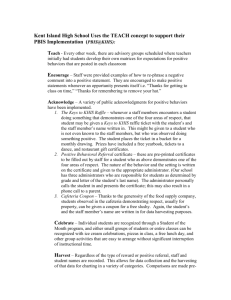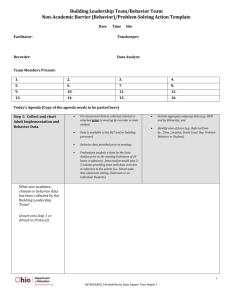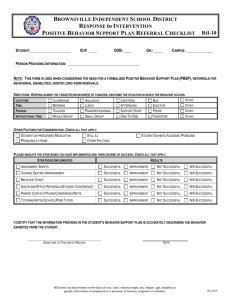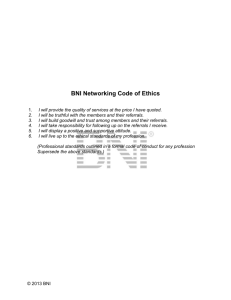Bert Eliason, Do We Say All But Mean Some?
advertisement
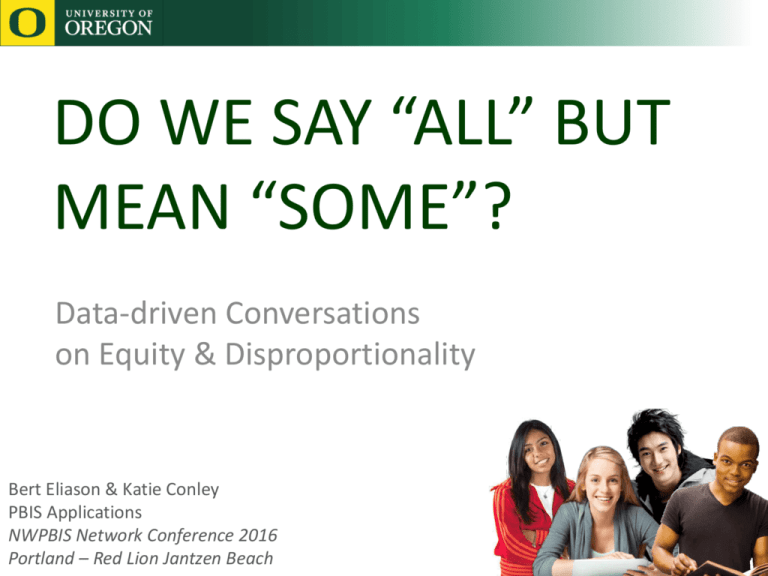
DO WE SAY “ALL” BUT MEAN “SOME”? Data-driven Conversations on Equity & Disproportionality Bert Eliason & Katie Conley PBIS Applications NWPBIS Network Conference 2016 Portland – Red Lion Jantzen Beach Educational and Community Supports Educational and Community Supports (ECS) is a research unit within the College of Education at the University of Oregon. • ECS focuses on the development and implementation of practices that result in positive, durable, and scientifically substantiated change in the lives of individuals. • Federal and state funded projects support research, teaching, dissemination, and technical assistance. PBIS Applications (PBISApps) is a series of educational tools created within ECS and related to the implementation of multi-tiered systems of support (MTSS). • The PBIS Application tools have been utilized in 25,000+ schools both domestically and internationally. www.pbis.org School Equity & PBIS Data Sources: What is Necessary? Required features: • Consistent data collection • Discipline referrals (ODRs) • Student race/ethnicity • School enrollment by race/ethnicity • Instantaneous access for school teams—not just district teams • Capability to disaggregate ODRs and patterns by race/ethnicity • Capability to calculate risk indices and risk ratios by race/ethnicity Data Sources: What is Recommended? Standardized forms with the 5W’s • Who, what, when, where, why Clear definitions of problem behaviors Clear guidance in discipline procedures • Office vs. staff-managed Report generation • On demand • Disaggregated by race/ethnicity • Automatic calculation of disproportionality Problem Solving Model Why is it happening? Is there a problem? Is the plan working? 1. Problem Identification 2. Problem Analysis 4. Plan Evaluation 3. Plan Implementation What should be done? Step 1: Problem Identification Problem-solving approach Is there a problem? 1. Problem Identification • Use valid & reliable metrics • Quantify the difference between current outcomes and goals • 62% of students have 0-1 ODR (at least 80% recommended) • 38% of students have 2+ ODRs For disproportionality • Quantify outcomes across racial/ethnic groups • Compare differences • Racial Subgroups vs. White Multiple metrics are recommended Step 1: Problem Identification Common Metrics Risk Index • Percent of a group at risk for an outcome (e.g., receiving an ODR) Number of Black Students with 1 or more ODR 41 = 70 = .59 Number of Black Students Enrolled SWIS Ethnicity Reports Referral Risk Index Step 1: Problem Identification Common Metrics Risk Ratio Risk index for one group divided by the risk index for comparison group • Comparison group is usually White students • 1.0 is equal risk • > 1.0 is overrepresentation • < 1.0 is underrepresentation Risk Index of Target Group Risk Index of Latino Students .82 Risk Index of Comparison Group Risk Index of White Students .65 Risk Index of Black Students .59 Risk Index of White Students .65 = 1.27 = 0.91 Step 1: Problem Identification Common Metrics Risk Ratio • Free Risk Ratio Calculator from Wisconsin RtI Center www.wisconsinrticenter.org Step 1: Problem Identification Common Metrics Composition – Percent of Students with Referrals • Compares subgroup’s percentage of school population to the subgroup’s percentage of just the students with ODRs • Is the number students with ODRs for one subgroup proportionate to that subgroup’s size within the school? SWIS Ethnicity Reports Students with Referrals by Ethnicity Step 1: Problem Identification Common Metrics Composition – Percent of Total Referrals • Compares subgroup’s percentage of school population to the subgroup’s percentage of all ODRs written • Is the number of ODRs for one subgroup proportionate to that subgroup’s size within the school? SWIS Ethnicity Reports Referrals by Ethnicity Step 1: Problem Identification Procedure 1. Select metrics to use 2. Calculate metrics and compare to goals • Previous years from same school • Local or national norms • 2011-2012 U.S. public schools using SWIS with at least 10 African American and 10 White students • Median risk ratio (African American to White) = 1.84 • 25th percentile = 1.38 • Logical criteria • U.S. Equal Employment Opportunity Commission (EEOC) • Disparate impact criterion – “4/5s Rule” • Goal risk ratio range between .80 and 1.25 School Example: Rainie Middle School School-wide Information System (SWIS) • Calculate risk indices • Calculate risk ratios • African American = 3.2 (significant) • Use US EEOC risk ratio goal range • Latino/a = 1.1 60 50 40 30 20 10 0 48 Percent of School Enrollment Socio-economic 31 Paid 28% 20 1 White African Latino/a American Asian FRL 72% Step 2: Problem Analysis Why is it happening? Is there a problem? 1. Problem Identification 2. Problem Analysis Step 2: Problem Analysis Purpose: Identify underlying causes of the problem Focus: Systems & practices that can be changed Evaluate: Is the disproportionality identified consistent across all situations or more pronounced in some situations? • Explicit bias vs. Implicit bias • Disproportionality in all settings vs. Specific settings Implicit Bias Unconscious, automatic Based on stereotypes We all have it (even those affected by it) Generally not an indication of our beliefs and values More likely to influence: • Snap decisions • Decisions that are ambiguous A Unidimensional View of Bias Racial Bias Disproportionate Discipline A Multidimensional View of Bias Racial Bias Vulnerable Decision Point Disproportionate Discipline Situation What is a Vulnerable Decision Point A specific decision that is more vulnerable to effects of implicit bias Two parts: • Elements of the situation • The person’s decision state (internal state) Two Systems for Decision Making System 1: Fast Decisions • Automatic, snap judgments • Intuitive, unconscious System 2: Slow Decisions • Deliberate decisions • Allows for conscious attention Kahneman, 2011 VDPs from national ODR data Subjective problem behavior • Defiance, Disrespect, Disruption • Major vs. Minor Non-classroom areas • Hallways • Playgrounds Afternoons Step 2: Problem Analysis Purpose: Identify underlying causes of the problem Focus: Systems and practices that can be changed Step 2: Problem Analysis Defining Disproportionate Discipline with Precision • Who is involved? • What are the problem behaviors? • Where is it happening? • When is it happening? • Why are these things happening? • Perceived function of problem behavior Step 2: Problem Analysis Vulnerable Decision Point (VDP) Identified Subgroup Location Time of Day Problem Behavior Motivation Assess • PBIS implementation fidelity • Achievement gap Many sixth grade Latino/a students in the 7th grade are more likely to receive referrals from the classroom, cafeteria, & commons for inappropriate language and physical aggression. Referrals are perceived to be task avoidance and getting adult attention. SWIS Ethnicity Reports & Drill Down Total enrollment is approx. 25% Latino, but of total number of students with referrals 30% of the them are Latino/a. Total enrollment is approx. 25% Latino, but almost 29% of the total referrals are given to Latino/a students. There are 123 Latino/a students enrolled and 101 of them have been given a referral. With a risk index of 0.82, 82% of Latino/a students are at risk for or have already received a referral. SWIS Drill Down Precise Problem Statement SWIS Drill Down Subgroup: Latino/a Students Who? When? What? M-Disruption, Inappropriate Language, Defiance 3rd grade After 12:00 PM 4th grade 8:00 AM– 11:30 AM M-Defiance 7th grade After 12:00 PM Inappropriate Lang., Physical Aggression, M-Inappropriate Lang. Where? Why? All settings Avoid task Classroom Avoid task Classroom Cafeteria Commons Avoid task Obtain Adult Attention Precise Problem Statements Latino/a students in the 3rd grade are more likely to receive referrals in the afternoon across all settings for disrespect, inappropriate language, and disruption. Referrals are related to task avoidance. Latino/a students in the 4th grade are more likely to receive referrals from the classroom during the morning instructional block for defiance. Referrals are related to task avoidance. Latino/a students in the 7th grade are more likely to receive referrals from the classroom, cafeteria, & commons for inappropriate language and physical aggression. Referrals are related to task avoidance and getting adult attention. School Example: Rainie Middle School RMS PBIS Team Meeting Decisions 1. Use SWIS Drill Down to build precise problem statements 2. Assess PBIS implementation 3. Assess academic gaps School Example: Rainie Middle School Vulnerable Decision Point (VDP) Latino/a 6th grade students Identified Subgroup Location Time of Day Problem Behavior Motivation are receiving referrals throughout the day in the classroom, cafeteria, & commons for inappropriate language and dress code violations. Referrals are perceived to be related to getting peer and adult attention. School Example: Rainie Middle School Assess PBIS implementation TFI shows Tiers I, II, and III meet benchmark Team still wants to work on improving ODR process Major vs Minor Office vs Staff Tiered Fidelity Inventory (TFI) School Example: Rainie Middle School Assess academic gaps African American and Latino/a students lagging in reading proficiency. 100 80 60 40 20 0 29 71 10 56 48 Reading 90 44 52 Not Met Met Step 3: Plan Implementation Why is it happening? Is there a problem? 1. Problem Identification 2. Problem Analysis 3. Plan Implementation What should be done? Step 3: Plan Implementation Information from Step 2 is used to select strategies. An action plan is created to ensure adequate implementation of the strategies. Action plans show everyone - WHO will do WHAT by WHEN. Step 3: Plan Implementation Options • All issues • Calculate and share disproportionality data regularly • Inadequate PBIS implementation • Implement core features of PBIS to establish a foundation of support • Misunderstandings regarding school-wide expectations • Enhance culturally-responsive PBIS with input from the students/families • Academic achievement gap • Implement effective academic instruction • Disproportionality across all settings (indicating explicit bias) • Enact strong anti-discrimination policies that include accountability • Disproportionality in specific settings (indicating implicit bias) • Neutralize vulnerable decision points School Example: Rainie Middle School Step 4: Plan Evaluation Why is it happening? Is there a problem? Is the plan working? 1. Problem Identification 2. Problem Analysis 4. Plan Evaluation 3. Plan Implementation What should be done? Step 4: Plan Evaluation Evaluation Time Frame: Identify time periods for evaluating disproportionality data Caution: Disproportionality metrics may not be sensitive to rapid change • Consider monthly assessment of implementation & quarterly assessment of disproportionality metrics • Avoid using risk indices as they will increase throughout the year Step 4: Plan Evaluation 1. Assess progress and fidelity of plan implementation 2. Calculate metrics from Step 1 3. Compare to the goal determined in Step 1 4. Share results with relevant stakeholders School Example: Rainie Middle School • 6th grade team may need a refresher on office vs. staff-managed behaviors African American ODR Risk Ratio 4 3.5 3 2.5 2 1.5 1 0.5 0 Risk Ratio October January March June • Revise action plan for next year • Continue evaluation cycle Problem Solving Model Why is it happening? Is there a problem? Is the plan working? 1. Problem Identification 2. Problem Analysis 4. Plan Evaluation 3. Plan Implementation What should be done? Data-driven Conversations on Equity & Disproportionality Use your available tools and resources to make sure you are offering all students their best chance for success. Bert Eliason & Katie Conley PBIS Applications training@pbisapps.org NWPBIS Network Conference 2016
